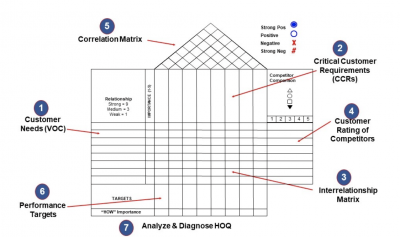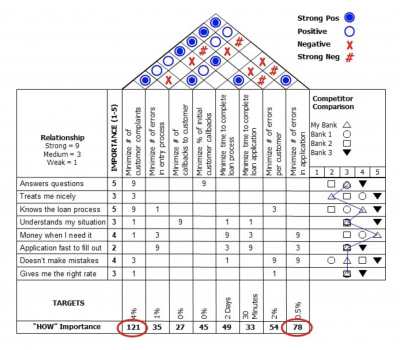
Key Points
- House of Quality is a matrix showing how a customer’s wants relate directly to the hard specifications of a product.
- Proper implementation allows you to plan out all the stages of a given production.
- Focusing on HOQ allows you to exceed customer desires, delivering the best possible product or service you can.
House of Quality is a summary diagram that is used as part of a structured approach to transform your voice of customer requirements into actual product specifications. This approach is called Quality Function Deployment (QFD).
This article will discuss how to build the HOQ and present the benefits of the HOQ. Additionally, you’ll also learn some best practices for building and using the HOQ to develop your process or product. This will help you meet your customers’ needs and expectations.
Overview: What Is House of Quality?
House of Quality, or HOQ, is a product planning matrix that is used to show how your customer requirements relate directly to the actions you can take to achieve those requirements.
HOQ diagrams resemble the shape of a house and should be created using direct customer input if applicable. HOQ is considered the primary tool in QFD. It serves as the roadmap for describing the journey from the initial idea to the final product or service specifics.
Below is the template used for building your house.

Let’s briefly run through each room, the attic, and the basement to see how you can build this HOQ.
- Customer needs: For each critical customer segment, capture customer feedback and VOC input consisting of your customer’s needs and the priority or weight of each need.
- Customer critical requirements: The top row of the house contains the critical customer requirements (CCRs), also referred to as critical to customer (CTC).
- Interrelationship matrix: Evaluate the relationship between your customer needs and CCRs. Determine the relative importance of each CCR.
- Customer rating of your competitors: How does your customer perceive the marketplace and your competition’s ability to meet each of their requirements?
- Correlation matrix: Compare CCRs to determine if they conflict with each other, leverage each other, or have no effect on each other.
- Performance targets: Determine the necessary performance targets (specs) for each CCR.
Below is an example of developing a new loan product for a bank. Note that the two design areas most important to the customer are reducing customer complaints (121) and minimizing errors in the application (78). It also seems that Bank 3 does a better job at meeting the requirements of the customer, and you should probably benchmark against them.

Benefits of HOQ
Although it can be a bit of a pain to develop and build your HOQ, the benefits of having all of the elements in one easy-to-read diagram far outweigh the work and effort required to develop it.
Organize Your Efforts to Satisfy Your Customers
The HOQ document is structured and the elements are linked. You can’t complete the house without building out each room.
Focus Your Development
Your focus is on customer needs and how to meet them using specific and quantifiable targets and metrics.
Understand Your Customer Needs and Document Their Requirements
The HOQ forces you to drive everything to meet your customer’s needs. By documenting and defining these needs, you will have a written and documented baseline. Subsequently, you can then work towards developing the best design you can.
Why Is HOQ Important to Understand?

While the diagram is simple in design, you must understand the correlation and interrelationships between the rooms.
Powerful Tool
The power of HOQ is in the collaboration of team members, the input of the customer, and the deep understanding of how to convert the customer’s whats to the design hows.
Correlation
Two rooms require you to understand and correlate relationships between them. You will need to understand what and how to do that and the relevancy of the importance ratings.
Delivering on the Requirements
It’s one thing to design a process or product to meet your customer’s needs. That said, it’s another to have the ability to produce that product or deliver that service. However, It will be important to coordinate with the rest of the organization. They will need to understand how they can make your design tangible.
An Industry Example of HOQ
A large hospital chain decided to create a chain of freestanding clinics for general medical practices to alleviate some of the pressure on their emergency rooms. As such, the CEO, who had some Six Sigma training, decided to use QFD to design the clinic and patient experience.
They followed the steps and built a HOQ. This required gathering patient feedback, determining processes, assessing the physical attributes of the clinic, correlating them, and setting targets. They also gathered competitive information about other clinics, both privately run and hospital-based.
In the end, they developed an optimal design that would satisfy their patient requirements and, at the same time, be feasible enough to build and manage the physical clinics.
Why It Matters
It can seem daunting to implement HOQ in your design stage. However, by understanding customer requirements you can hone in on what features, specifications, or other details are most important for satisfying the voice of the customer. At the end of the day, a business lives and dies by its customers, so honing in on the right elements can be crucial.
Best Practices When Thinking About HOQ

As I alluded to at the beginning of this article, the HOQ is often referred to as the HOP or House of Pain. By following some best practices, you may be able to reduce that pain.
Direct and Well-defined Customer Requirements
Don’t assume that you know what your customer wants or needs. Get that information directly from them, and be sure everyone agrees as to what they mean and how they will be measured.
Think Quantitative, Not Just Qualitative
The more things you can measure — and are supported by data — the less you leave to emotion and subjectivity.
Think Outside the Box, but Be Realistic
You may not be able to always design and deliver the world’s next best thing. Keep in mind the capabilities of your organization to deliver what you are designing.
Other Useful Tools and Concepts
HOQ is just one part of Quality Function Deployment. This concept is rooted in designing products that fit customer needs in a given market segment. To learn how this concept relates to something like software development, I heavily recommend our guide covering the subject.
Additionally, you might want to learn about how QFD can help avoid a project’s failure. There is nothing worse than launching or releasing a new deliverable and receiving a lukewarm or negative reception. Learning how this approach can transform your deliverables is a great way of keeping things in perspective when developing new products.
Let’s Do a Final Tour of Your House of Quality
The HOQ combines the various elements of a design process all in one easy-to-understand diagram. Subsequently, it starts with the customer and their requirements and ends with specific design solutions intended to meet those requirements.
Along the way, you identify targets and priorities and correlate design elements and requirements even to the point of benchmarking against your competitors.